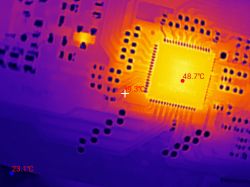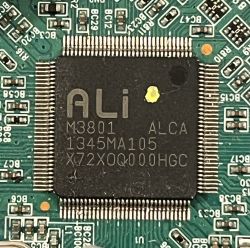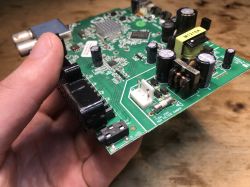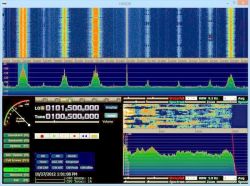Structures with inductance in the diagram are often troublesome to commissioning for electronic beginners. Some people can easily go through the stages of building AM receivers to superheterodyne receivers, for others it is a difficult barrier. Ready-made radio modules are a significant facilitation, for example, allowing for easy activation of digital transmission in ISM bands.
A step further is SDR - software defined radio. The SDR receiver is usually based on a ready module supplying digital samples of I and Q signals. These samples come from mixers, on which the input signal and orthogonal signals from the local PLL generator were fed. The rest happens in the software processing I and Q signals. Sounds complicated, but we use such a solution, for example, when watching DVB-T TV on a broadband USB receiver and software installed on a laptop.
What do you think about SDR receivers, do you prefer a traditional receiver design for specific bands or broadband SDR?
Due to the mass production, USB DVB-T and DAB + receivers are very cheap. The receivers are miniature, powered from USB and cover the band from several dozen MHz to 1.8 GHz. It turned out that RTL2832U-based receivers can provide I&Q samples for use in a program other than that provided by the manufacturer for television and radio reception. This enabled hobbyists to receive signals on the amateur bands, as well as, for example, NOAA satellite weather maps, signals from ADS-B transponders, meteorological radios and many others.
Usage programs type SDR # , HDSDR , GNU radio and a USB receiver for several dozen zlotys, allows you to start the listening receiver. You can find quite good descriptions of the launch here: RTL-SDR . Such a receiver can be helpful in many cases, e.g. for starting radio modules for digital transmissions. Application examples: https://www.rtl-sdr.com/about-rtl-sdr/
For more demanding customers, more expensive devices with the ability to work from single KHz to 2GHz have appeared https://www.sdrplay.com/rsp1a/, https://airspy.com/airspy-hf-plus/ as well as devices with the 1MHz to 6GHz range and the possibility of broadcasting, for example, https://greatscottgadgets.com/hackrf/, but in basic applications a "dongle" for PLN 40-60 is sufficient.
The use of the USB DVB-T receiver requires the installation of the appropriate driver: https://www.rtl-sdr.com/rtl-sdr-quick-start-guide/
On this page: http://www.websdr.org/ you will find SDR receivers that enable online listening via a browser. Some receivers listed on the website are located in Poland.
Do you have experience with SDR receivers, what do you use them for?
Source:
https://www.rtl-sdr.com/
http://www.websdr.org/
http://www.hdsdr.de/
A step further is SDR - software defined radio. The SDR receiver is usually based on a ready module supplying digital samples of I and Q signals. These samples come from mixers, on which the input signal and orthogonal signals from the local PLL generator were fed. The rest happens in the software processing I and Q signals. Sounds complicated, but we use such a solution, for example, when watching DVB-T TV on a broadband USB receiver and software installed on a laptop.
What do you think about SDR receivers, do you prefer a traditional receiver design for specific bands or broadband SDR?
Due to the mass production, USB DVB-T and DAB + receivers are very cheap. The receivers are miniature, powered from USB and cover the band from several dozen MHz to 1.8 GHz. It turned out that RTL2832U-based receivers can provide I&Q samples for use in a program other than that provided by the manufacturer for television and radio reception. This enabled hobbyists to receive signals on the amateur bands, as well as, for example, NOAA satellite weather maps, signals from ADS-B transponders, meteorological radios and many others.
Usage programs type SDR # , HDSDR , GNU radio and a USB receiver for several dozen zlotys, allows you to start the listening receiver. You can find quite good descriptions of the launch here: RTL-SDR . Such a receiver can be helpful in many cases, e.g. for starting radio modules for digital transmissions. Application examples: https://www.rtl-sdr.com/about-rtl-sdr/
For more demanding customers, more expensive devices with the ability to work from single KHz to 2GHz have appeared https://www.sdrplay.com/rsp1a/, https://airspy.com/airspy-hf-plus/ as well as devices with the 1MHz to 6GHz range and the possibility of broadcasting, for example, https://greatscottgadgets.com/hackrf/, but in basic applications a "dongle" for PLN 40-60 is sufficient.
The use of the USB DVB-T receiver requires the installation of the appropriate driver: https://www.rtl-sdr.com/rtl-sdr-quick-start-guide/
On this page: http://www.websdr.org/ you will find SDR receivers that enable online listening via a browser. Some receivers listed on the website are located in Poland.
Do you have experience with SDR receivers, what do you use them for?
Source:
https://www.rtl-sdr.com/
http://www.websdr.org/
http://www.hdsdr.de/
Cool? Ranking DIY








